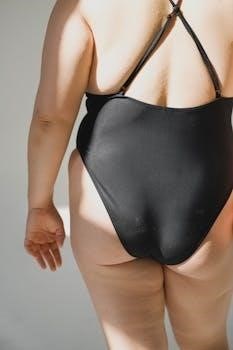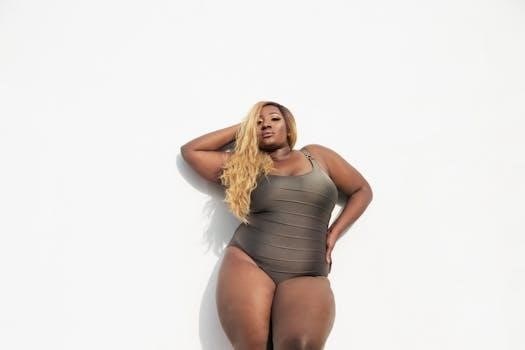Navigating the world of swimwear sizing can be tricky. This guide provides comprehensive information to help you find the perfect fit. From understanding size charts to measuring yourself accurately, we cover all aspects of swimwear sizing. Learn about different sizing systems and tips for choosing between sizes.
Swimwear sizing can often feel like a different language compared to regular clothing. Unlike your everyday dresses or jeans, swimwear sizing considers factors like stretch, compression, and how the fabric behaves when wet. It’s not uncommon to find yourself needing a different size in swimwear than you typically wear. This is because swimwear is designed to fit snugly to provide support and maintain its shape, especially when in the water.
This guide is designed to demystify the process and help you find the perfect swimsuit that fits and flatters your body. We’ll explore various aspects of swimwear sizing, including understanding size charts, taking accurate measurements, and considering different body types. You will also learn about the variations in sizing across different regions and brands.
Whether you’re shopping for a bikini, a one-piece, or a swim dress, knowing how to navigate swimwear sizing is crucial. It ensures comfort, confidence, and a stylish look for your aquatic adventures. We’ll also discuss how to use swimsuit size calculators and what to do if you’re between sizes. Ultimately, this guide aims to empower you with the knowledge you need to make informed decisions and enjoy your swimwear shopping experience.
Importance of Accurate Measurements
Taking accurate measurements is the cornerstone of finding swimwear that fits perfectly and enhances your figure. Unlike regular clothing, swimwear is designed to be form-fitting. Therefore, even slight inaccuracies in your measurements can lead to discomfort, unflattering silhouettes, or even the swimsuit not fitting at all. Accurate measurements ensure that you select the correct size based on the brand’s size chart, minimizing the chances of ordering the wrong size.
Furthermore, precise measurements help you understand your body shape and proportions better. This knowledge is invaluable when choosing styles that complement your figure. Knowing your bust, waist, and hip measurements allows you to identify the most suitable cuts, support levels, and coverage options. It also helps in selecting features like underwire, padding, or adjustable straps that cater to your specific needs.
Accurate measurements also save you time and money by reducing the need for returns and exchanges. By investing a few minutes in taking precise measurements, you can avoid the hassle of dealing with ill-fitting swimwear. Ultimately, accurate measurements empower you to make confident decisions, ensuring that your swimwear fits comfortably, looks flattering, and allows you to fully enjoy your time in the water.
How to Measure Yourself for Swimwear
Achieving the perfect swimwear fit begins with accurate self-measurement. Gather a flexible measuring tape, a mirror, and a well-fitting, non-padded bra. Stand tall with your feet shoulder-width apart. To measure your bust, wrap the measuring tape around the fullest part of your chest, keeping it parallel to the ground. Ensure the tape is snug but not too tight.
Next, locate your natural waistline, usually the narrowest part of your torso. Wrap the measuring tape around your waist, ensuring it’s parallel to the ground and comfortably snug. For your hips, stand with your feet together and measure around the fullest part of your hips and buttocks. Keep the tape parallel to the ground.
Record each measurement in inches or centimeters, depending on the size chart you’ll be using; It’s helpful to have someone assist you for more accurate readings. Measure several times to verify consistency. Remember, swimwear sizes can vary between brands, so always refer to the specific size chart provided by the manufacturer.
These measurements – bust, waist, and hips – are crucial for determining your appropriate swimwear size. Accurate self-measurement ensures a comfortable and flattering fit, enhancing your confidence and enjoyment while wearing your swimsuit.
Swimsuit Size Calculator Tools
Swimsuit size calculator tools are invaluable resources for simplifying the process of finding the right size. These online tools use algorithms to estimate your ideal swimsuit size based on your body measurements. They eliminate much of the guesswork involved in traditional size charts, making the shopping experience more efficient and accurate.
To use a swimsuit size calculator, you typically input your bust, waist, and hip measurements. Some calculators may also ask for your bra size or height. Once you’ve entered these details, the calculator processes the information and provides a recommended swimsuit size, often specific to a particular brand or retailer.
These tools are particularly helpful when shopping online, where trying on swimsuits is not an option. They provide a quick and convenient way to narrow down your size range, reducing the likelihood of ordering the wrong size. However, it’s essential to remember that calculators are estimates, and individual body shapes and swimsuit styles can still affect the final fit.
Always double-check the calculator’s recommendation against the brand’s size chart, and consider reading customer reviews to get a better sense of how the swimsuits tend to fit. Combining the calculator’s estimate with other sources of information will help you make a more informed decision and increase your chances of finding the perfect-fitting swimsuit.
Understanding Swimwear Size Charts
Swimwear size charts are essential tools for finding the right fit, but understanding how to use them is crucial. These charts typically list body measurements alongside corresponding sizes, allowing you to determine the best size based on your specific measurements. However, it’s important to recognize that size charts can vary significantly between brands.
Before consulting a size chart, take accurate measurements of your bust, waist, and hips using a flexible measuring tape. Ensure the tape is snug but not too tight. Compare your measurements to the chart, paying attention to the specific units (inches or centimeters) used. If your measurements fall between sizes, consider the swimsuit’s style and fabric.
For example, a more compressive fabric might warrant sizing up, while a looser style could allow for sizing down. Pay close attention to any notes provided on the size chart, as these can offer valuable insights into the swimsuit’s fit. Also, remember that size charts are just a guide, and individual body shapes can influence how a swimsuit fits.

Always check customer reviews for feedback on sizing accuracy. Some brands may run small or large, and reviews can provide helpful information. By carefully analyzing size charts and considering these additional factors, you can improve your chances of finding a swimsuit that fits comfortably and flatters your figure.
Swimsuit Sizing by Body Type
Choosing a swimsuit that flatters your body shape is crucial for feeling confident and comfortable. Different swimsuit styles complement different body types. Understanding your body shape can significantly improve your swimsuit shopping experience. Common body shapes include pear, apple, rectangular, hourglass, and inverted triangle.
Pear-shaped bodies, characterized by wider hips than shoulders, often benefit from swimsuits that balance the upper and lower body. Strapless bandeau tops, padded bikini tops, or those with embellishments can add volume to the upper body. Apple-shaped bodies, with a fuller midsection, can look great in swimsuits that draw attention away from the waist. Low necklines and supportive underwire can create a flattering silhouette.
Rectangular shapes can benefit from swimsuits that create the illusion of curves. Halter bikinis, triangle tops, or one-piece swimsuits with ruffles can add dimension. Hourglass figures often look stunning in belted one-piece swimsuits or low-cut bikini bottoms that accentuate the waist. Inverted triangle shapes can be balanced with swimsuits that add volume to the lower body, such as those with ruffles or bold prints on the bottoms.
Remember that these are general guidelines, and personal preference is key. The most important factor is finding a swimsuit that makes you feel confident and comfortable. Don’t be afraid to try different styles and sizes to find what works best for you.
Swimsuit Sizing⁚ US vs. EU vs. UK/AU
Swimsuit sizing can vary significantly between different regions, making it essential to understand the conversions between US, EU, UK, and Australian sizes. This knowledge ensures you select the correct size regardless of where you are purchasing your swimwear.
In the United States, swimsuits are typically labeled with numerical sizes ranging from 0 to 16, with size 8 often being considered the medium. European sizes are generally numerical from 28-42, where 36 is considered medium. UK and Australian sizes range from 8-16, where 12 is the medium.
When buying a swimsuit, it can be difficult to read the different sizing systems used around the world. Different countries usually have different ways to size clothing and swimsuits. To convert between these systems, refer to a comprehensive size chart. These charts provide a direct comparison, allowing you to easily find the equivalent size in your preferred system. Keep in mind that sizing can also vary between brands, so always check the specific size chart provided by the manufacturer.
Understanding these regional differences can prevent frustration and ensure a more accurate fit when shopping online or in international stores; Utilizing size conversion charts is a simple way to navigate the complexities of global swimwear sizing.

Tips for Choosing Between Sizes
Deciding between two swimsuit sizes can be challenging. When in doubt, consider a few key factors to make the best choice. Always prioritize comfort; a swimsuit that’s too tight can be restrictive and unflattering, while one that’s too loose may not provide adequate support or coverage.
If you are unsure or between sizes, should you size up or down with swimsuits? Our general answer is that you should always size down when it comes to swimsuits. Swimsuits are elastic and will stretch, especially in water. However, if you go with a swimsuit that is too large for you it will be saggy and wont look good at all. Thats why we always recommend going with a smaller size if you are unsure about swimsuits!
Consider the style of the swimsuit. Some styles, like those with adjustable straps or ties, offer more flexibility in fit. If you’re purchasing online, check the retailer’s return policy in case the first size you try doesn’t work out. Reading customer reviews can also provide valuable insights into how a particular swimsuit style tends to fit.
Ultimately, the best way to choose between sizes is to try on both, if possible, and assess which one feels more comfortable and looks more flattering on your body.
Swimsuit Material and Fit Considerations
The material of a swimsuit significantly affects its fit and performance. Different fabrics offer varying degrees of stretch, support, and durability. Spandex, also known as Lycra, is a common component in swimsuits due to its excellent elasticity and ability to retain its shape. Swimwear fabric naturally… Please note that due to the thickness of our fabrics and our suits shape controlling properties, they should feel quite snug or tight initially ⎻ especially when first putting on;
Consider how the fabric will perform when wet. Some materials may become heavier or more transparent when wet, affecting the fit and coverage. The construction of the swimsuit, including features like lining, underwire, and boning, also plays a role in its overall fit and support. If you are unsure of which size to get, please reach out to our fit specialists! … If you dont have a measuring tape handy, measure the area with a piece of string and hold the marked spot up to a ruler).
The fit of a swimsuit should be snug but not constricting, allowing for freedom of movement in the water. Pay attention to areas like the bust, waist, and hips to ensure a comfortable and flattering fit.
Special Swimwear Sizes⁚ Kids and Plus Size
Finding the right swimwear can be more challenging for kids and plus-size individuals due to varying body shapes and growth patterns. Kids’ swimwear sizing often considers age, height, and weight. It’s essential to consult size charts specific to children’s swimwear, as sizes can differ significantly between brands. This chart is intended for childrens sizing only. ALL MEASUREMENTS LISTED ARE IN INCHES. Weight is in pounds. BOYS. SIZE-XS 4/5 22 S 6/7 …
For plus-size swimwear, accurate measurements are crucial. Focus on bust, waist, and hip measurements to find the best fit. Plus size Determine your … Round to the nearest inch. Then subtract your band size and look up the result on the cup size chart below. For example, if your band measurement was 34 and your cup measure was 36, you would do the following⁚ 36 ⎻ 34 2 on the chart, 2 B. Your complete bra size is your band size number followed by the cup size letter.
Consider swimwear with features like adjustable straps, supportive linings, and power-mesh panels for enhanced comfort and shaping. Swimwear Plus Size Determine your … Consider the cut and style of the swimwear to flatter your figure and provide adequate coverage. Prioritize comfort and confidence when selecting swimwear in these specialized sizes.
Finding the Perfect Fit⁚ Trying On and Adjustments
The ultimate test of swimwear is trying it on. When trying on swimsuits, move around to ensure comfort and proper fit. Check the fit in the bust, waist, and hips. The swimsuit should feel snug but not constricting. Swimwear fabric naturally… Pay attention to the straps and ensure they don’t dig into your shoulders. Note that due to the thickness of our fabrics and our suits shape controlling properties, they should feel quite snug or tight initially ⎯ especially when first putting on.

Look for any areas that gap or feel too tight. Don’t hesitate to try on multiple sizes and styles to find the best match for your body. If you find a swimsuit that’s almost perfect, consider alterations. Adjustable straps can help fine-tune the fit around the bust and shoulders.

Some swimsuits have removable pads that can be adjusted for a more customized fit. If a swimsuit is too loose in certain areas, a tailor can often make adjustments to improve the overall fit. Ultimately, the goal is to find a swimsuit that makes you feel confident and comfortable, so don’t settle for anything less than the perfect fit.


